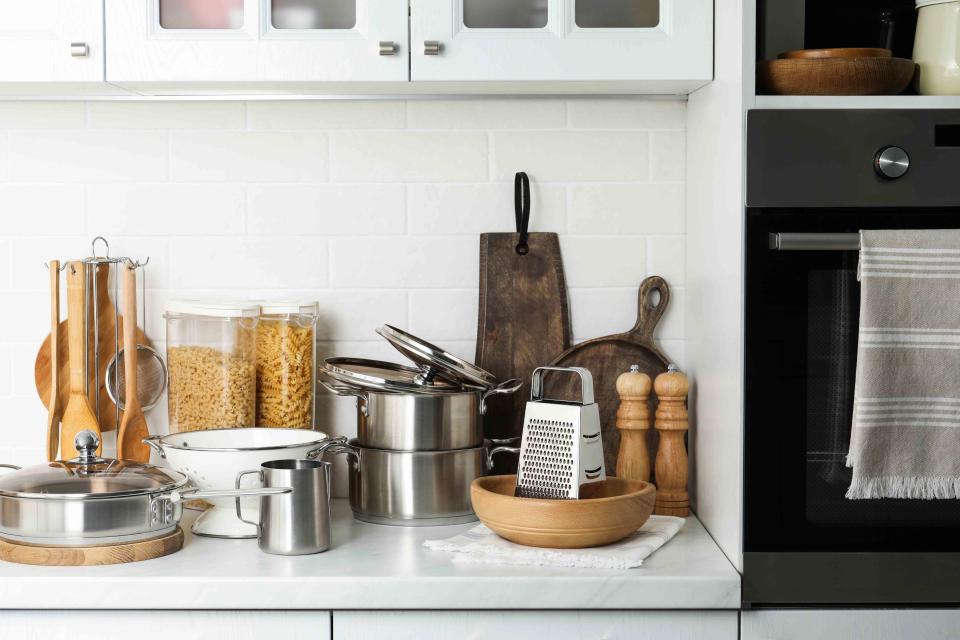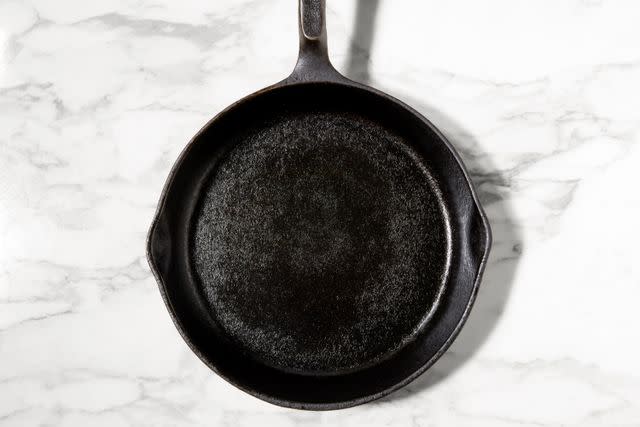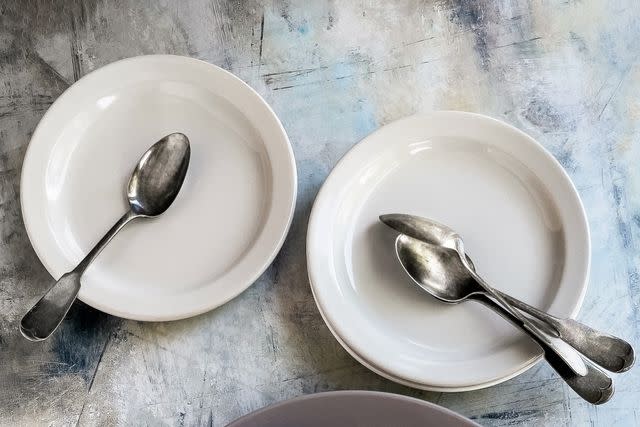Surprising Ways to Use Everyday Kitchen Items, From a Cast Iron Skillet to a Teaspoon
Bet you didn't realize these cooking essentials had so many hidden talents.

Liudmila Chernetska / GETTY IMAGES
In the age of culinary gadgets (think air fryers, Instant Pots, and high-speed blenders), it can be easy to take the most classic, reliable kitchen items for granted. But unlike specialty appliances with singular hi-tech functions, these timeless tools are incredibly versatile—and we bet you haven't even yet scratched the multi-purpose surface. From box graters and cast iron skillets to rolling pins and teaspoons, these familiar items have several surprise uses in store.

Liudmila Chernetska / GETTY IMAGES
Related:Your Cast-Iron Skillet Can (and Should!) Last Forever—Here's How to Turn It Into a Family Heirloom
Box Grater

Liudmila Chernetska / GETTY IMAGES
Who doesn't have a simple box grater in their kitchen cabinet? Beyond shredding cheese, potatoes for latkes, and zucchini for fritters, your trusty grater can do so much more.
Preparing Tomatoes
Skinning, seeding, and chopping tomatoes for cooking? Not necessary when you have a standard box grater. Simply slice a fresh tomato in half, hold the cut side against the grater's teeth, and rub up and down over a bowl. The skin may tear a bit, but it stays on one side of the grater—while the flesh drops into the bowl. Remove the tomato seeds by digging them out with your fingertips first if your recipe requires.
Pie Crust
Pastry cooks know the secret to a tender, flaky pie crust is using a light hand when mixing and incorporating the butter into the flour just enough. You can use the large holes of a grater to grate butter for your dough, making the steps of mixing that much more efficient. Measure the amount of butter you will need for your dough, and freeze it until very firm before you proceed. Then, grate it into the flour and toss lightly with your fingertips to coat.
Mincing Garlic
The small holes of a grater (or a microplane zester) create minced garlic finer than anyone can chop in a fraction of the time. Set the grater over a small bowl or jar before grating. Then, use that bowl or jar for whisking together a vinaigrette.
Cast Iron Skillet

Gregory Kramer / GETTY IMAGES
A cast iron skillet is the pan many of us rely on most. Its heft and material make it useful for developing a crisp crust on most foods and it also retains heat well—so it works for frying, but can turn out a golden-brown cornbread and skillet pies, too. When well-seasoned (read well-loved), a cast iron pan becomes virtually non-stick.
Pizza Stone
Did you know that in addition to frying your chicken and your eggs, you can use your large cast iron skillet as a pizza stone? Simply turn it upside down and place it in the oven before preheating it. It will become as hot as the oven temperature, and the flat, dark surface will help brown the bottom of a dough as it cooks.
Sandwich or Bacon Press
A medium or small cast iron skillet is the perfect press for a panini, grilled cheese sandwich, bacon, or a brick-pressed chicken. Wrap the underside of the skillet in foil and use it as a weight to press on top of the food as it cooks in a larger pan. If you preheat the skillet, it will give extra sizzle and browning as you work. Add a couple of cans of tomatoes to the top for extra weight as needed.
Spice Grinder
Crushing peppercorns with a small cast iron skillet gives a coarse butcher-grind for coating steak au poivre or pasta cacio e pepe. Place the pepper on a firm, flat surface and spread them out with your hand. Hold the skillet at an angle and press down on the peppercorns; then press the other end of the skillet down, dragging it over the peppercorns firmly. You will hear the peppercorns crunch as you lift and press repeatedly.
Strainer

Getty Images
A basic strainer or sieve is very useful. We pull it out almost every day to rinse vegetables, but its applications are tenfold. Sieves of different dimensions and hole sizes also have different abilities.
Burn Preventer
A large sieve makes an excellent spatter guard. Place it upside down over a sizzling skillet and you won't have grease flying everywhere, especially onto your arms (ouch!). It's particularly handy if you're frying anything that pops dangerously, like soft shell crabs or chicken livers.
Hazelnut Hutch
When a recipe calls for toasted hazelnuts, remember to rub the bitter skins off the toasted nuts before you use them. You can wrap them in a dish towel and rub away—but a less messy way to do this is to roll the toasted hazelnuts around in the bottom of a strainer, pressing them with your hand. The texture and shape make quick work of removing the skins. When you're done, lift the nuts out, leaving the skins behind.
Impromptu Steamer
A stainless-steel strainer set inside a pot can double as a steamer basket, as long as it sits above the water level. Avoid using wire mesh sieves for this job, as they may become rusty.
Herb Leaf Stripper
When trying to pull thyme leaves from their stems, it’s easy to miss a lot of leaves, or end up with woody stems on your leg of lamb. Instead, let the strainer to help. One at a time, pull herb stems though the strainer's holes. It will make clumsy fingers feel nimbler.
Bug Guard
Setting out a salad on a summer day? Why not use a large strainer to keep the flying pests away until it's time to eat? Turn a sieve upside down over the plate and protect your food.
Ricer

Cultura RM Exclusive/BRETT STEVENS / GETTY IMAGES
The perfect tool for making fluffy mashed potatoes, a ricer may seem like it only has one purpose.
Strainer
Beyond Thanksgiving duty, you can also use it to press liquid from cooked greens. Use the ricer for any recipe where watery spinach just won't do, such as spanakopita, gnudi, or spinach pasta dough.
Juicer
Need to make a large batch of margaritas or a key lime pie, but you don't have an electric juicer to a friend? Save time: Quarter limes or lemons, and place a few in the barrel of a ricer; place over a pitcher and squeeze the handles together firmly. You can squeeze the juice from a handful of citrus wedges at a time. Wash the citrus before you start.
Rolling Pin

Florin Ciobanu / 500px / GETTY IMAGES
There are times we need a rolling pin for more than making cookies or pie.
Meat Pounder
Making chicken parm or pork schnitzel for dinner? Use a rolling pin for pounding sliced chicken breasts into thin, even cutlets. A heavy, marble rolling pin will have the best results. You can also use it to tenderize a tough steak.
Lobster Tool
If you're going to the trouble of cooking lobster, you'll want to be sure to get all this luxury meat out of its shell. Each leg contains a small, but sweet snack—add it to your lobster rolls or seafood pasta.
First, twist the legs off the lobster body and lay them flat on a work counter. Use your rolling pin to extract the tender meat from those tiny lobster legs by rolling the pin along each leg, starting at the claw end; the pressure of the rolling pin will squeeze the meat out of the shell.
Related:Martha Shows Us the Right Way to Shell a Lobster, Just in Time for Summer
Teaspoon

Claudia Totir / GETTY IMAGES
One of the simplest items in our kitchen, the teaspoon is small, but mighty. Consider all this measuring tool does for us: It stirs, lifts, portions, and feeds us tastes of soups. Small spoons in particular have a few special superpowers.
Ginger Peeler
It tuns out there is nothing more efficient for peeling ginger than a teaspoon. Hold the curved tip of a spoon against the ginger and scrape lightly along it; the skin comes off more easily than if you had tried to use a paring knife. There is no waste—and the spoon's shape makes it defter at navigating the ginger's bumps and curves than a peeler.
Kiwi Handler
It can be hard to slice a ripe kiwi without damaging its tender flesh or leaving too much of it behind. Try this: Slice off the two ends of a kiwi and insert a teaspoon between the skin and the flesh, with the back of the spoon touching the inside of the skin. Now rotate the spoon against the flesh in one motion. Separate the kiwi from its skin and scoop it out. Success—no juice lost.
Stubborn Lid Remover
This tip comes from the former manager of our test kitchen, Geri Porter. A strong teaspoon (not a thin antique one) can help open stubborn jar lids; hold a small spoon (preferably one with a slightly pointed end) upright with its back to you, (the curved interior facing the jar). Place the tip of the spoon under the lid of the jar and twist firmly a couple of times. You will hear a satisfying pop as it unseals the lid from the jar.

